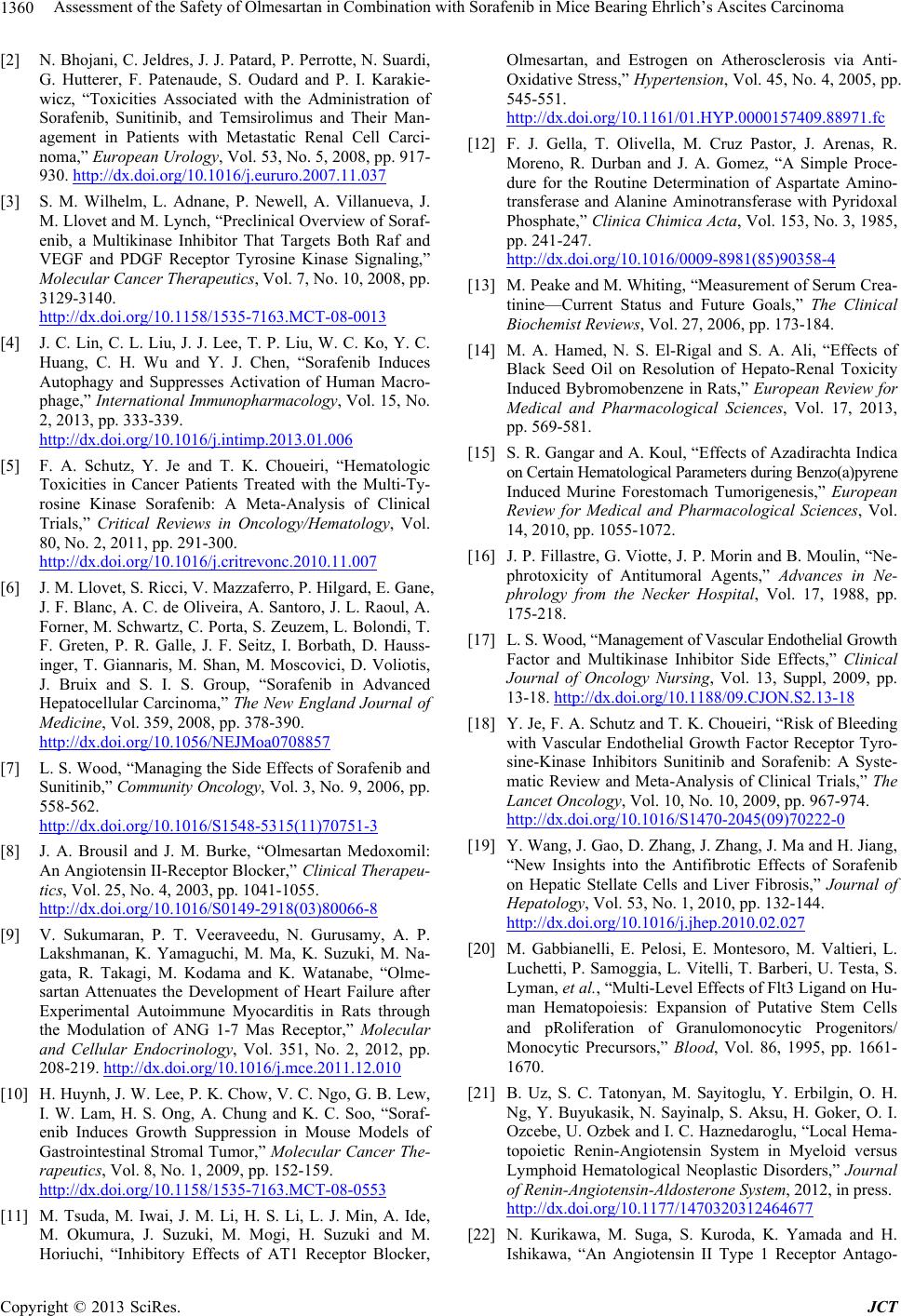
Assessment of the Safety of Olmesartan in Combination with Sorafenib in Mice Bearing Ehrlich’s Ascites Carcinoma
1360
[2] N. Bhojani, C. Jeldres, J. J. Patard, P. Perrotte, N. Suardi,
G. Hutterer, F. Patenaude, S. Oudard and P. I. Karakie-
wicz, “Toxicities Associated with the Administration of
Sorafenib, Sunitinib, and Temsirolimus and Their Man-
agement in Patients with Metastatic Renal Cell Carci-
noma,” European Urology, Vol. 53, No. 5, 2008, pp. 917-
930. http://dx.doi.org/10.1016/j.eururo.2007.11.037
[3] S. M. Wilhelm, L. Adnane, P. Newell, A. Villanueva, J.
M. Llovet and M. Lynch, “Preclinical Overview of Soraf-
enib, a Multikinase Inhibitor That Targets Both Raf and
VEGF and PDGF Receptor Tyrosine Kinase Signaling,”
Molecular Cancer Therapeutics, Vol. 7, No. 10, 2008, pp.
3129-3140.
http://dx.doi.org/10.1158/1535-7163.MCT-08-0013
[4] J. C. Lin, C. L. Liu, J. J. Lee, T. P. Liu, W. C. Ko, Y. C.
Huang, C. H. Wu and Y. J. Chen, “Sorafenib Induces
Autophagy and Suppresses Activation of Human Macro-
phage,” International Immunopharmacology, Vol. 15, No.
2, 2013, pp. 333-339.
http://dx.doi.org/10.1016/j.intimp.2013.01.006
[5] F. A. Schutz, Y. Je and T. K. Choueiri, “Hematologic
Toxicities in Cancer Patients Treated with the Multi-Ty-
rosine Kinase Sorafenib: A Meta-Analysis of Clinical
Trials,” Critical Reviews in Oncology/Hematology, Vol.
80, No. 2, 2011, pp. 291-300.
http://dx.doi.org/10.1016/j.critrevonc.2010.11.007
[6] J. M. Llovet, S. Ricci, V. Mazzaferro, P. Hilgard, E. Gane,
J. F. Blanc, A. C. de Oliveira, A. Santoro, J. L. Raoul, A.
Forner, M. Schwartz, C. Porta, S. Zeuzem, L. Bolondi, T.
F. Greten, P. R. Galle, J. F. Seitz, I. Borbath, D. Hauss-
inger, T. Giannaris, M. Shan, M. Moscovici, D. Voliotis,
J. Bruix and S. I. S. Group, “Sorafenib in Advanced
Hepatocellular Carcinoma,” The New England Journal of
Medicine, Vol. 359, 2008, pp. 378-390.
http://dx.doi.org/10.1056/NEJMoa0708857
[7] L. S. Wood, “Managing the Side Effects of Sorafenib and
Sunitinib,” Community Oncology, Vol. 3, No. 9, 2006, pp.
558-562.
http://dx.doi.org/10.1016/S1548-5315(11)70751-3
[8] J. A. Brousil and J. M. Burke, “Olmesartan Medoxomil:
An Angiotensin II-Receptor Blocker,” Clinical Therapeu-
tics, Vol. 25, No. 4, 2003, pp. 1041-1055.
http://dx.doi.org/10.1016/S0149-2918(03)80066-8
[9] V. Sukumaran, P. T. Veeraveedu, N. Gurusamy, A. P.
Lakshmanan, K. Yamaguchi, M. Ma, K. Suzuki, M. Na-
gata, R. Takagi, M. Kodama and K. Watanabe, “Olme-
sartan Attenuates the Development of Heart Failure after
Experimental Autoimmune Myocarditis in Rats through
the Modulation of ANG 1-7 Mas Receptor,” Molecular
and Cellular Endocrinology, Vol. 351, No. 2, 2012, pp.
208-219. http://dx.doi.org/10.1016/j.mce.2011.12.010
[10] H. Huynh, J. W. Lee, P. K. Chow, V. C. Ngo, G. B. Lew,
I. W. Lam, H. S. Ong, A. Chung and K. C. Soo, “Soraf-
enib Induces Growth Suppression in Mouse Models of
Gastrointestinal Stromal Tumor,” Molecular Cancer The-
rapeutics, Vol. 8, No. 1, 2009, pp. 152-159.
http://dx.doi.org/10.1158/1535-7163.MCT-08-0553
[11] M. Tsuda, M. Iwai, J. M. Li, H. S. Li, L. J. Min, A. Ide,
M. Okumura, J. Suzuki, M. Mogi, H. Suzuki and M.
Horiuchi, “Inhibitory Effects of AT1 Receptor Blocker,
Olmesartan, and Estrogen on Atherosclerosis via Anti-
Oxidative Stress,” Hypertension, Vol. 45, No. 4, 2005, pp.
545-551.
http://dx.doi.org/10.1161/01.HYP.0000157409.88971.fc
[12] F. J. Gella, T. Olivella, M. Cruz Pastor, J. Arenas, R.
Moreno, R. Durban and J. A. Gomez, “A Simple Proce-
dure for the Routine Determination of Aspartate Amino-
transferase and Alanine Aminotransferase with Pyridoxal
Phosphate,” Clinica Chimica Acta, Vol. 153, No. 3, 1985,
pp. 241-247.
http://dx.doi.org/10.1016/0009-8981(85)90358-4
[13] M. Peake and M. Whiting, “Measurement of Serum Crea-
tinine—Current Status and Future Goals,” The Clinical
Biochemist Reviews, Vol. 27, 2006, pp. 173-184.
[14] M. A. Hamed, N. S. El-Rigal and S. A. Ali, “Effects of
Black Seed Oil on Resolution of Hepato-Renal Toxicity
Induced Bybromobenzene in Rats,” European Review for
Medical and Pharmacological Sciences, Vol. 17, 2013,
pp. 569-581.
[15] S. R. Gangar and A. Koul, “Effects of Azadirachta Indica
on Certain Hematological Parameters during Benzo(a)pyrene
Induced Murine Forestomach Tumorigenesis,” European
Review for Medical and Pharmacological Sciences, Vol.
14, 2010, pp. 1055-1072.
[16] J. P. Fillastre, G. Viotte, J. P. Morin and B. Moulin, “Ne-
phrotoxicity of Antitumoral Agents,” Advances in Ne-
phrology from the Necker Hospital, Vol. 17, 1988, pp.
175-218.
[17] L. S. Wood, “Management of Vascular Endothelial Growth
Factor and Multikinase Inhibitor Side Effects,” Clinical
Journal of Oncology Nursing, Vol. 13, Suppl, 2009, pp.
13-18. http://dx.doi.org/10.1188/09.CJON.S2.13-18
[18] Y. Je, F. A. Schutz and T. K. Choueiri, “Risk of Bleeding
with Vascular Endothelial Growth Factor Receptor Tyro-
sine-Kinase Inhibitors Sunitinib and Sorafenib: A Syste-
matic Review and Meta-Analysis of Clinical Trials,” The
Lancet Oncology, Vol. 10, No. 10, 2009, pp. 967-974.
http://dx.doi.org/10.1016/S1470-2045(09)70222-0
[19] Y. Wang, J. Gao, D. Zhang, J. Zhang, J. Ma and H. Jiang,
“New Insights into the Antifibrotic Effects of Sorafenib
on Hepatic Stellate Cells and Liver Fibrosis,” Journal of
Hepatology, Vol. 53, No. 1, 2010, pp. 132-144.
http://dx.doi.org/10.1016/j.jhep.2010.02.027
[20] M. Gabbianelli, E. Pelosi, E. Montesoro, M. Valtieri, L.
Luchetti, P. Samoggia, L. Vitelli, T. Barberi, U. Testa, S.
Lyman, et al., “Multi-Level Effects of Flt3 Ligand on Hu-
man Hematopoiesis: Expansion of Putative Stem Cells
and pRoliferation of Granulomonocytic Progenitors/
Monocytic Precursors,” Blood, Vol. 86, 1995, pp. 1661-
1670.
[21] B. Uz, S. C. Tatonyan, M. Sayitoglu, Y. Erbilgin, O. H.
Ng, Y. Buyukasik, N. Sayinalp, S. Aksu, H. Goker, O. I.
Ozcebe, U. Ozbek and I. C. Haznedaroglu, “Local Hema-
topoietic Renin-Angiotensin System in Myeloid versus
Lymphoid Hematological Neoplastic Disorders,” Journal
of Renin-Angiotensin-Aldosterone System, 2012, in press.
http://dx.doi.org/10.1177/1470320312464677
[22] N. Kurikawa, M. Suga, S. Kuroda, K. Yamada and H.
Ishikawa, “An Angiotensin II Type 1 Receptor Antago-
Copyright © 2013 SciRes. JCT